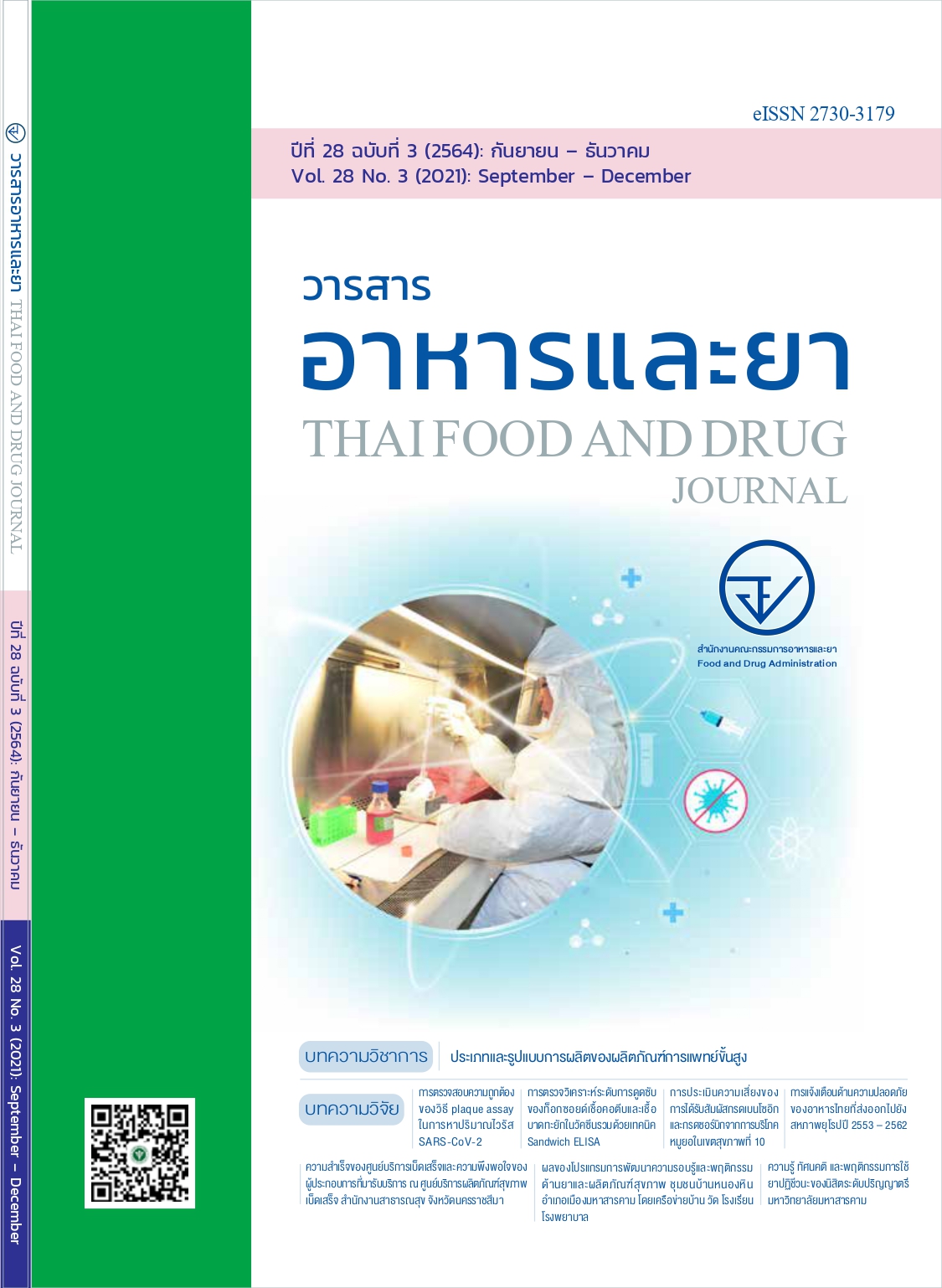Safety Notifications on Thai Food Exported to the European Union in 2010-2019
Main Article Content
Abstract
Background: Food export to the European Union (EU) is a major source income for Thailand. However, some of these products were not through import to the EU countries due to food safety hazards detection that caused a negative impact on economy and reputation of Thailand.
Objective: To study the statistics of Thai food safety notifications and analyze the causes of Thai food product notifications in the EU from 2010 to 2019.
Methods: The data for this study was collected the Thai food product notification data by using the EU’s Rapid Alert System for Food and Feed (RASFF) database. Then, it classified the food categories, food safety hazards, and notifying countries as descriptive statistics.
Results: It is found that the Thai food product notifications of the EU caused from chemical, biological and physical hazards, absence of certificates, and transportation quality issues. A major food that noticed includes: (1) fruit and vegetable contaminated pesticides; sulfite; and genetic modification, (2) poultry contaminated Salmonella, (3) seafood contaminated histamine and cadmium, and (4) feed that contaminated mercury; arsenic; and Salmonella. Moreover, a case of frozen food, most of them were controlled unsuitable temperature during transport which the products were declined whether destroyed at ports. The EU’ Countries where very strict on food import inspection were Finland, Denmark, Norway, and Germany.
Conclusions: Although the number of Thai food notifications in the EU tended to decline, it still had food safety hazards continually: pesticides, Salmonella, and heavy metals.
Article Details
References
ต.ค 2563]. เข้าถึงจาก: http://www2.ops3.moc.go.th/
2. ชนวัฒน์ สิทธิธูรณ์, วรพงศ์ วิไลรัตน์. ข้อเท็จจริง “ระบบแจ้งเตือน/กักกันสินค้าสหรัฐ-อียู” สินค้า
เกษตรไทยถูกปฏิเสธการนำเข้าสหรัฐอเมริกา และสหภาพยุโรป [อินเทอร์เน็ต]. 2559 [เข้าถึงเมื่อ
20 ธ.ค 2563]. เข้าถึงจาก:
http://www.thaitribune.org/contents/detail/327?content_id=22912
3. Brans H. EU-28 Food and Agricultural Import Regulations and Standards - Narrative.
GAIN Report Number E17080 [Internet]. 2017 [cited 2020 May 30]. Available from:
https://www.usda-eu.org/trade-with-the-eu/eu-import-rules/fairs-reports/
4. Lüth S, Boone I, Kleta S, Al Dahouk S. Analysis of RASFF notifications on food
products contaminated with Listeria monocytogenes reveals options for
improvement in the rapid alert system for food and feed. Food Control. 2019;96:479–
87. doi:10.1016/j.foodcont.2018.09.033.
5. European Commission. RASFF portal [Internet]. 2020 [cited 2020 May 10].
Available from: https://ec.europa.eu/food/safety/rasff/portal_en
6. กระทรวงพาณิชย์. ตลาดส่งออกสำคัญของไทยรายสินค้า [อินเทอร์เน็ต]. 2563 [เข้าถึงเมื่อ 25
ธ.ค. 2563]. เข้าถึงจาก: http://tradereport.moc.go.th/TradeThai.aspx
7. Foundation FSSC 22000. Certified organizations [Internet]. 2021 [cited 2021 Feb 4].
Available from: https://www.fssc22000.com/certified-organizations/
8. Pigłowski M. The correlation analysis of alert notifications in the RASFF to food from
the non-EEA countries and from the EEA countries. LogForum. 2015;11 (3):237-245.
doi:10.17270/J.LOG.2015.3.3.
9. Kallummal M, Gupta A, Varma P. Exports of agricultural products from South-Asia and impact of SPS measures : a case study of European Rapid Alert System for Food and Feed (RASFF). J Econ Policy Res. 2013;8(2):41-75.
10. อัทธ์ พิศาลวานิช. การศึกษาผลกระทบการเปิดเสรีทางการค้าของ WTO ต่อสินค้าเกษตรและอุตสาหกรรมเกษตรของประเทศไทย : การวิเคราะห์แบบจำลองดุลยภาพทั่วไป. รายงานการศึกษาฉบับสมบูรณ์ สำนักงานกองทุนสนับสนุนการวิจัย. 2543.
11. European Commission. EU Pesticides Database [Internet]. 2020 [cited 2020 Dec 18].
Available from: https://ec.europa.eu/food/plant/pesticides/eu-pesticides-db_en
12. European Union. RASFF Annual Report 2018 [Internet]. 2019 [cited 2020 Jun 8].
Available from: https://ec.europa.eu/food/safety/rasff/reports_publications_en
13. Blunden S, Wallace T. Tin in canned food: a review and understanding of
occurrence and effect. Food Chem Toxicol. 2003;41(12):1651–62. doi:10.1016/s0278-
6915(03)00217-5.
14. Kim HT, Loftus JP, Mann S, Wakshlag JJ. Evaluation of arsenic, cadmium, lead and
mercury contamination in over-the-counter available dry dog foods with different
animal ingredients (red meat, poultry, and fish). Front Vet Sci. 2018;5:264.
doi:10.3389/fvets.2018.00264.
15. Adamse P, Van der Fels-Klerx HJ, de Jong J. Cadmium, lead, mercury and arsenic
in animal feed and feed materials – trend analysis of monitoring results. Food Addit
Contam Part A. 2017 Aug;34(8):1298–311. doi:10.1080/19440049.2017.1300686.
16. Pádua I, Moreira A, Moreira P, Melo de Vasconcelos F, Barros R. Impact of the
regulation (EU) 1169/2011: Allergen-related recalls in the rapid alert system for food
and feed (RASFF) portal. Food Control. 2019;98:389–98.
doi:10.1016/j.foodcont.2018.11.051.
17. Pigłowski M. Pathogenic and non-pathogenic microorganisms in the Rapid Alert
System for Food and Feed. Int J Environ Res Public Health. 2019;16(3):477.
doi:10.3390/ijerph16030477.
18. Bouzembrak Y, Marvin HJP. Prediction of food fraud type using data from Rapid
Alert System for Food and Feed (RASFF) and Bayesian network modelling. Food
Control. 2016;61:180–7. doi:10.1016/j.foodcont.2015.09.026.
19. European Commission. EU Coordinated Control Programmes [Internet]. 2021 [cited
2021 Feb 4]. Available from: https://ec.europa.eu/food/safety/official_ controls/eu-
coordinated-control-plans_en

